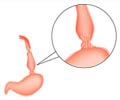Thickened skin over palms and soles is related to an inherited form of esophageal cancer.
- Tylosis is an inherited condition characterized by thickened skin over the palms and soles
- It is associated with an increased incidence of esophageal cancer
- ‘Gain of function’ mutation of iRHOM2 gene seen in Tylosis
- Targeting iRHOM2 gene might lead to newer treatment options in esophageal cancer
What Causes Thickened Skin over Palms and Soles?
The increased thickness of the skin over the palms and soles is due to the abundance of a protein called keratin.
The palms and soles are uniquely adapted to withstand physical stress due to a variety of day-to-day activities such as housework, walking and running. This strength and resilience is provided by the protein keratin which forms a framework inside the cells of the skin. The skin of the palms and soles consist of a type of keratin called K16. K16 is also formed in increased amounts during wound healing processes and in inflammatory conditions of the skin.
Interestingly, K16 is a biomarker of a variety of cancer called squamous cell cancer seen in the esophagus, cervix and nasopharynx.
Tylosis is a rare inherited disorder characterized by extremely thick skin over the palms and soles due to increased deposition of keratin. Persons suffering from this condition also have an increased risk of developing squamous cell cancer of the esophagus.
A loss of iRHOM2 is associated with decreased expression of K16 and thinning of the footpads of mice.
The above findings outline an important role for iRHOM2 gene in regulating the epithelial cell response to physical stress and why persons who indulge in hard physical work involving hands have thickened and callused palms.
Conclusions From the Study
Targeting the iRHOM2 gene could open up new treatment options in esophageal cancer. Further research on iRHOM2 gene mutation might offer new insights into skin conditions such as psoriasis and skin cancer.
References:
- RHBDF2 Mutations Are Associated with Tylosis, a Familial Esophageal Cancer Syndrome - (https://www.ncbi.nlm.nih.gov/pmc/articles/PMC3276661/)
Source-Medindia













